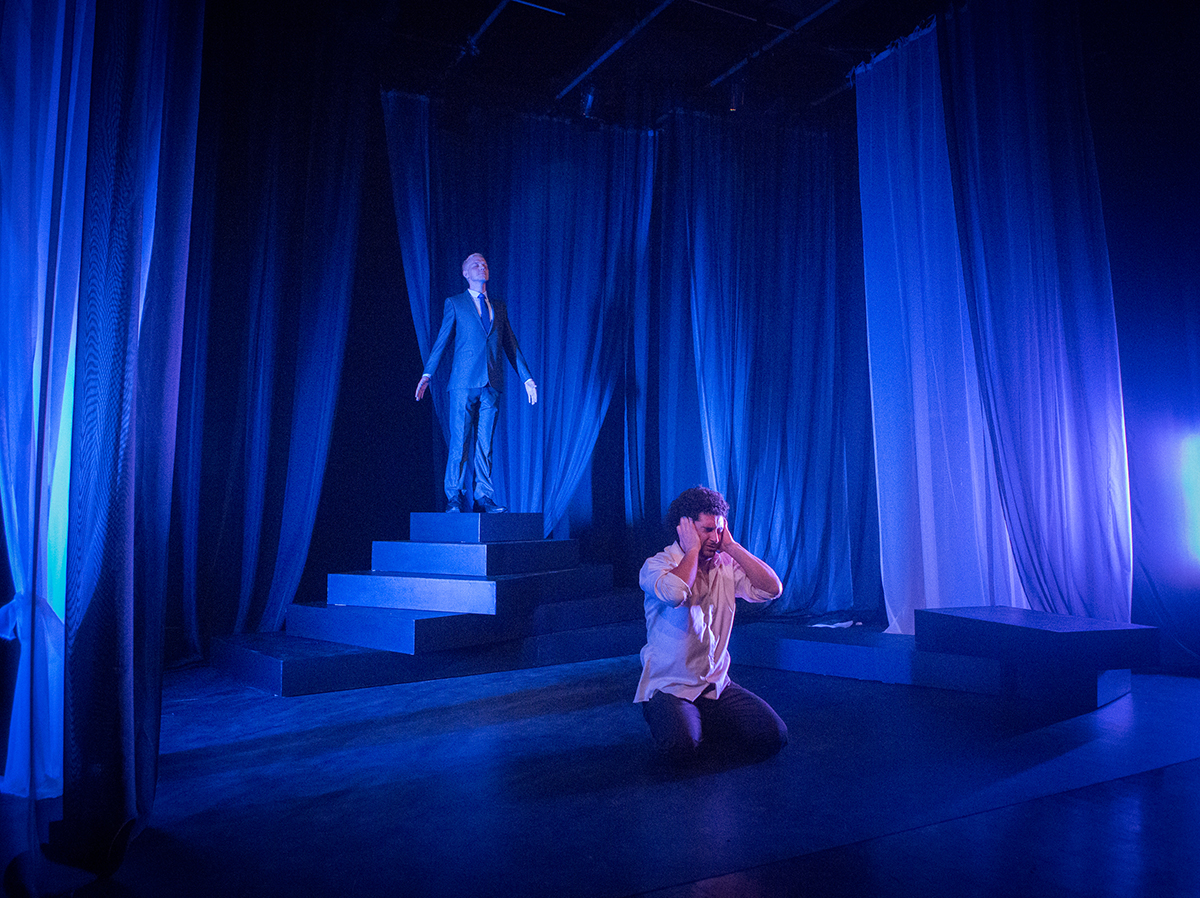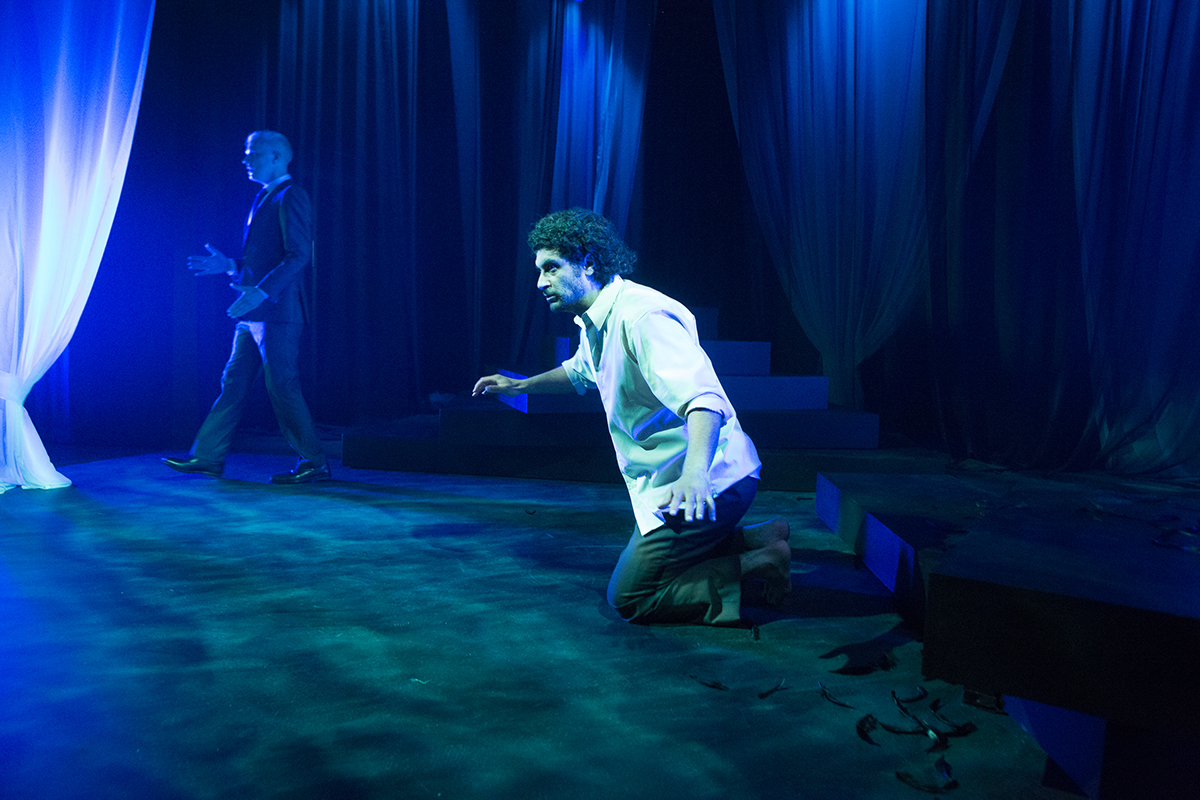
The Sound of Waiting: why not a place for everyone?
Mary Anne Butler’s The Sound of Waiting is a response to former Leader of the Opposition in the Australian Government Tony Abbot’s comment in 2010 that “Jesus knew there was a place for everything, and it is not necessarily everyone’s place to come to Australia.” An allegory for a world that has closed its door on humanity, The Sound of Waiting uses magic realism to deep-dive on the question: as a global community, where do we go from here?
With just two characters, a refugee called Hamed, and an Angel of Death, Butler’s script is economical but her words have wings. Under the direction of Gail Evans (who directed Butler’s award-winning play Broken [2015]), Kyle Walmsley is devastatingly effective as the suited Angel of Death, his narcissism monumental. At the other end of the spectrum is Hamed Mokri, convincingly played by Osamah Sami, who embodies the trauma of millions of faceless refugees the world over.
The minimalist set by Kris Bird and lighting design by Jessie Davis evoke the enormous landscape of Butler’s imagination. With a stack of blocks, sheer voile backdrops and white, red and blue filtered light, The Sound of Waiting appears as beautiful as it is terrible. It takes you from war to sea, and below into its inky depths. You can’t look away.

The Sound of Waiting, photo Glenn Campbell courtesy Brown’s Mart Theatre
The play opens with a soliloquy from the Angel of Death: “There is a space between sea and sky… the whisper between hope and despair… And if a person can reach in there — if they can grab that tiny sliver of light-capped possibility — then the rest of their life… will become golden-edged with opportunity.” Through the eyes of one refugee, Hamed, pitted against the Angel of Death, Butler explores that tiny space.
In a war-torn city, a bomb blast flings body parts of Hamed’s wife and small son past him in the street. He though is saved by the simple act of bending to tie his daughter’s shoelace. He notices that his son’s dismembered foot has one tiny stubbed toe. His wife’s scarf is caught on a bloody jaw bone. These details plunge us head-first into Hamed’s heartland. Based on an amalgam of asylum seeker stories, the drama is profound.
Hamed is barefoot and dishevelled, but it’s clear that he’s been a successful man. He clings to hope and logic in a world where life has been reduced to chance. We follow him as he deals with grief, escape plans, false documentation and officialdom. He and his daughter join the “river of refugees running to the ocean” and pack onto a boat. Hamed is every father — we ache at his loss, his desperation, we laugh at his jokes. We know this “leaking coffin” is his only hope.

The Sound of Waiting, photo Glenn Campbell courtesy Brown’s Mart Theatre
Presiding over Hamed’s suffering is the Angel of Death, faithful minion of the Host. White light accentuates his chiselled features. His neat grey suit has black feather epaulettes. We are inexorably drawn into the mindset of this figure, who pumps and thrusts and flies with practiced perfection. The Angel of Death is steely, magnificent, unmoved — and all too familiar. The loss of lives will guarantee his continued status. He has been charged with responsibility for ensuring Hamed’s demise. His words conjure a storm in which the sky teems with murderous angels, waves crash, the leaking vessel sinks and life jackets dissolve like tissue paper. As lives are lost, black feathers rain from the sky. The Angel rejoices, but Hamed hangs on. Undeterred, the Angel takes the shape of Hamed’s loved ones and lures him to the bottom of the ocean.
We know how this ends. Some lives weigh more than others. The outcome is pre-determined. There can be no survivors. There’s nothing we can do. And yet, when Hamed gives up, we find ourselves willing him to live. We want the Angel of Death to show mercy. We feel the energy shift. The Angel loses his bearings. Has Mary Anne Butler managed to draw us into that tiny space where new choices can be made? The Sound of Waiting should be on every stage in every city and town in Australia.
–
Knock-em-Down Theatre and Brown’s Mart Productions, The Sound of Waiting, writer Mary Anne Butler, director Gail Evans, set, performers Osamah Sami, Kyle Walmsley, costume designer Kris Bird, sound designer Matt Cunliffe, lighting designer Jessie Davis; Brown’s Mart Theatre, Darwin, 25 July-6 Aug
Top image credit: The Sound of Waiting, photo Glenn Campbell courtesy Brown’s Mart Theatre






